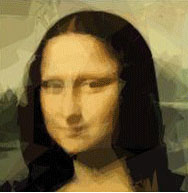What a difference every choice/decision point makes
 I was pointed to a website with an example of genetic programming where the result was a pretty darn good approximation of the Mona Lisa.
I was pointed to a website with an example of genetic programming where the result was a pretty darn good approximation of the Mona Lisa.
Roger Alsing had done the programming to just have some fun, try out some code — and I presume stretch a bit in a different direction than he usually got to try. He also put up an FAQ about the project. The FAQ says that he’s cleaning up the code he hacked together and “may” make it available if he manages to get it like he wants it. The FAQ also give his reasons for believing that it’s actually genetic programming — I happen to agree with him on this. I’d never really seen this applied to art before at least not that I remember so if I did, it probably wasn’t this impressive.
 I’m actually just intrigued with the approximation he got the original. His website has the series of photos that show how the program steadily got a better and better looking approximation of the painting. Here’s the last of the images.
I’m actually just intrigued with the approximation he got the original. His website has the series of photos that show how the program steadily got a better and better looking approximation of the painting. Here’s the last of the images.
I find it amazing that a simple program could just tool along for three hours and get so close to the original. It really makes you think about how decisions made at points based on just what’s around you can make a world of difference to what happens overall.
I’m just saying that, whether it’s DNA, programming, or people making choices based on the information they have available, we make patterns. As each individual choice effects those around them until your have picture or a pattern or an effect.
It’s amazing the power that we have to create our own world view, actions, and environment.
Really, visit his website and read about the process and the result — it’s truly fascinating.

True evolution isn’t driven by a desire for beauty, or anything else other than simple survivability. I.E. if I make more offspring (and my offspring make more offspring) than my competitors, I must be fitter. The problem is that Roger didn’t have millions of years to wait for something pretty to come out of his experiment. So he cheated a bit with the fitness function, making it: Do I look like the Mona Lisa. But this doesn’t change the fact that the polygons mutate and survive based on a fitness function, and it is therefore, in my opinion, an accurate, though severly simplified simulation of evolution through genetic selection. If you read through the comments on Rogers’ site, the disrespect and meanness is truly disheartening. Mostly though, they’re completely irrelevant to the point Roger was trying to make. If I show you a snowball I’ve made, then telling me it’s nothing like a glacier, while true, is rather pointless, and only serves to make you look like a gormless git with “anonymous-internet”itis.




